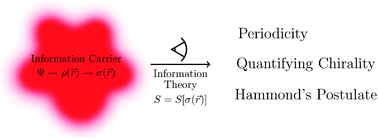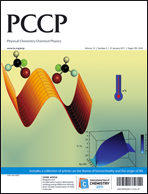Information carriers and (reading them through) information theory in quantum chemistry
Abstract
This Perspective discusses the reduction of the electronic wave function via the second-order reduced density ![[r with combining right harpoon above (vector)]](https://www.rsc.org/images/entities/i_char_0072_20d1.gif) ), which is the key ingredient in density functional theory (DFT) as a basic carrier of information. Simplifying further, the 1-normalized density function turns out to contain essentially the same information as ρ(
), which is the key ingredient in density functional theory (DFT) as a basic carrier of information. Simplifying further, the 1-normalized density function turns out to contain essentially the same information as ρ(![[r with combining right harpoon above (vector)]](https://www.rsc.org/images/entities/i_char_0072_20d1.gif) ) and is even of preferred use as an information carrier when discussing the periodic properties along Mendeleev's table where essentially the valence electrons are at stake. The Kullback–Leibler information deficiency turns out to be the most interesting choice to obtain information on the differences in ρ(
) and is even of preferred use as an information carrier when discussing the periodic properties along Mendeleev's table where essentially the valence electrons are at stake. The Kullback–Leibler information deficiency turns out to be the most interesting choice to obtain information on the differences in ρ(![[r with combining right harpoon above (vector)]](https://www.rsc.org/images/entities/i_char_0072_20d1.gif) ) or σ(
) or σ(![[r with combining right harpoon above (vector)]](https://www.rsc.org/images/entities/i_char_0072_20d1.gif) ) between two systems. To put it otherwise: when looking for the construction of a functional FAB = F[ζA(
) between two systems. To put it otherwise: when looking for the construction of a functional FAB = F[ζA(![[r with combining right harpoon above (vector)]](https://www.rsc.org/images/entities/i_char_0072_20d1.gif) ),ζB(
),ζB(![[r with combining right harpoon above (vector)]](https://www.rsc.org/images/entities/i_char_0072_20d1.gif) )] for extracting differences in information from an information carrier ζ(
)] for extracting differences in information from an information carrier ζ(![[r with combining right harpoon above (vector)]](https://www.rsc.org/images/entities/i_char_0072_20d1.gif) ) (i.e. ρ(
) (i.e. ρ(![[r with combining right harpoon above (vector)]](https://www.rsc.org/images/entities/i_char_0072_20d1.gif) ), σ(
), σ(![[r with combining right harpoon above (vector)]](https://www.rsc.org/images/entities/i_char_0072_20d1.gif) )) for two systems A and B the Kullback–Leibler information measure ΔS is a particularly adequate choice. Examples are given, varying from atoms, to molecules and molecular interactions. Quantum similarity of atoms indicates that the shape function based KL information deficiency is the most appropriate tool to retrieve periodicity in the Periodic Table. The dissimilarity of enantiomers for which different information measures are presented at global and local (i.e. molecular and atomic) level leads to an extension of Mezey's holographic density theorem and shows numerical evidence that in a chiral molecule the whole molecule is pervaded by chirality. Finally Kullback–Leibler information profiles are discussed for intra- and intermolecular proton transfer reactions and a simple SN2 reaction indicating that the theoretical information profile can be used as a companion to the energy based Hammond postulate to discuss the early or late transition state character of a reaction. All in all this Perspective's answer is positive to the question of whether an even simpler carrier of information than the electron density function ρ(
)) for two systems A and B the Kullback–Leibler information measure ΔS is a particularly adequate choice. Examples are given, varying from atoms, to molecules and molecular interactions. Quantum similarity of atoms indicates that the shape function based KL information deficiency is the most appropriate tool to retrieve periodicity in the Periodic Table. The dissimilarity of enantiomers for which different information measures are presented at global and local (i.e. molecular and atomic) level leads to an extension of Mezey's holographic density theorem and shows numerical evidence that in a chiral molecule the whole molecule is pervaded by chirality. Finally Kullback–Leibler information profiles are discussed for intra- and intermolecular proton transfer reactions and a simple SN2 reaction indicating that the theoretical information profile can be used as a companion to the energy based Hammond postulate to discuss the early or late transition state character of a reaction. All in all this Perspective's answer is positive to the question of whether an even simpler carrier of information than the electron density function ρ(![[r with combining right harpoon above (vector)]](https://www.rsc.org/images/entities/i_char_0072_20d1.gif) ) can be envisaged: the shape function, integrating to 1 by construction fulfils this role. On the other hand obtaining the information (or information difference) contained in one (or two) systems from ρ(
) can be envisaged: the shape function, integrating to 1 by construction fulfils this role. On the other hand obtaining the information (or information difference) contained in one (or two) systems from ρ(![[r with combining right harpoon above (vector)]](https://www.rsc.org/images/entities/i_char_0072_20d1.gif) ) or σ(
) or σ(![[r with combining right harpoon above (vector)]](https://www.rsc.org/images/entities/i_char_0072_20d1.gif) ) can be most efficiently done by using information theory, the Kulback–Leibler information deficiency being at the moment (one of) the most advisable functionals.
) can be most efficiently done by using information theory, the Kulback–Leibler information deficiency being at the moment (one of) the most advisable functionals.


 Please wait while we load your content...
Please wait while we load your content...